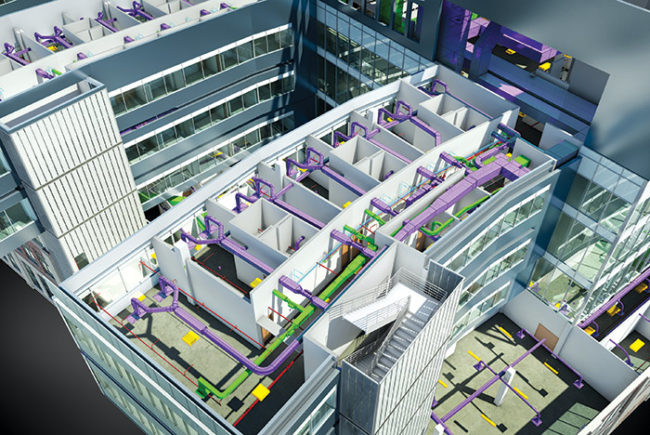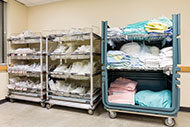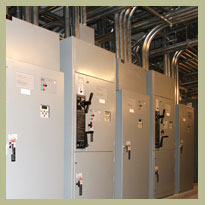
Three health care facilities faced a hurdle in managing a common issue — ensuring reliable critical power with a tight budget.
One wanted more sophisticated monitoring and control, automated testing and Joint Commission-acceptable report production. Another sought enhanced ability to continue following a “build-as-we-go” approach and to service equipment while it's “hot.” And a third wanted faster yet less-expensive connectivity for their electrical gear.
In short, they all wanted to continue ensuring the highest levels of patient safety, while optimizing their facilities' operational efficiency and mission. One, for example, serves as a regional, multi-state medical center. Another conducts world-class cancer research and patient treatment, and the third provides comprehensive women’s health care throughout all stages of life.
To reach these ends, each facility had a very different solution. Two retrofitted their critical power management system and the third built it from scratch. Their respective approaches offer food for thought for facilities managers facing the need to build or modernize their critical power management systems (CPMSs).
Monitoring and control
Bryan Medical Center east campus in Lincoln, Neb., is a regional health care campus serving patients throughout Nebraska and parts of Kansas, Iowa, South Dakota and other states.
The center's monitoring and control requirements for its power distribution system had outgrown its capabilities. Mike Wiruth, master electrician at the center, wanted highly automated and flexible monitoring, control and reporting functionalities that would simplify testing procedures and cut the time required to produce the automated test reports preferred by Joint Commission inspectors and the local fire marshal.
He needed a full-fledged CPMS to support the medical center's commitment to patient safety and help maintain its Joint Commission Gold Seal of Approval.
The east campus relies on its emergency system during normal source outages to power nearly all operations spanning the center's 1,075,000 square feet floor space, including a 382-bed hospital building.
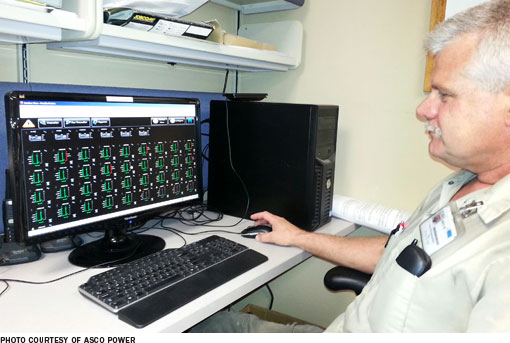 |
|---|
| Mike Wiruth, master electrician at Bryan Medical Center, sought upgraded monitoring and control capabilities. |
Monitoring and control capabilities needed to capture data from all CPMS gear — six decentralized generator sets totaling more than 4,000 kilowatts (kW) in rated capacity, bus bars, load banks, uninterruptable power supplies (UPSs) and 37 power transfer switches for life safety, critical and other branches of the distribution system. Retrofitting the onsite power system also required installing a new power monitoring and control system, upgrading software, replacing control panels, removing existing serial communications cards and changing communications medium from twisted pair RS485 to Ethernet.
The CPMS that Wiruth installed enables him to run automatic testing and Joint Commission test reports from a single computer screen.
"Now, we highlight multiple transfer switches on one computer screen and give one command to go," he says. "It's invaluable to do from one location from one screen."
He can monitor historical event logs, power readings and overall system operation, including actual generator load during tests, and trend generator-set load growth. He particularly values getting emails automatically on a variety of events and reports.
The system piggybacks on the center's existing virtual local area network ethernet network, which minimized installation time and avoided the labor and materials costs of running a secondary, RS485 twisted-pair communications structure.
Although there were inevitable potholes that required patience and persistence, he says, "It's been a good experience." As part of the array of benefits, "It helps us produce test reports that Joint Commission and the fire marshal accept," he emphasizes.
'Build as we go'
Mark Hungerford, operating engineer at Fred Hutchinson Cancer Research Center and Seattle Cancer Care Alliance, has wrestled with a conundrum faced by health facilities managers all too often — planning for infrastructure growth.
Should an infrastructure larger than needed in the near term be built for anticipated long-term growth? Or, should it be built to satisfy only near-term demand, with more infrastructure added later as needed? Much depends on the answer because the medical research and health care campus has grown six-fold since 1991 and now covers 15 acres and employs 4,000 people.
"We generally follow the model that was used for the first new building; meaning we start with a basic, robust infrastructure of high-quality equipment that will accommodate expansion, and grow out from there, when and where necessary," Hungerford says.
While the term infrastructure covers a lot of ground, Hungerford cites the campus' emergency power system as an example of adding equipment as needed. "We start by determining what loads should be on emergency power on the day the doors open, then build off that backbone as our needs and experiences dictate," he says.
This approach has served the campus well. Today, it's recognized for its reliable and right-sized infrastructure.
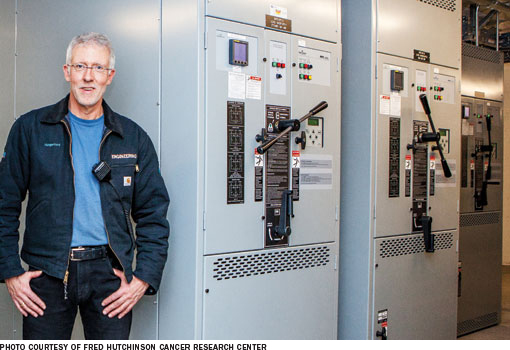 |
|---|
| Mark Hungerford, operating engineer at Fred Hutchinson Cancer Research Center and Seattle Cancer Care Alliance, stressed right-sized electrical infrastructure. |
Hungerford emphasizes, "It’s all about reliability. Everything, especially our data centers, are built to never go down." That's because campus operations scream “mission critical.” Data centers totaling 18,000 square feet store colossal volumes of information, including data from more than 200 research labs, patient prescriptions and employee payroll.
Power reliability also is critical for more than 900 freezers that maintain samples at sub-zero temperatures and to help ensure smooth patient flow.
The campus' emergency power infrastructure is based on a distributed topology with eight diesel generators developing nine megawatts (MW) of power at 480V and 22 low-voltage automatic transfer switches.
As part of ongoing work to boost reliability, Hungerford employed the vendor's service group and a qualified electrical contractor to convert two transfer switches to isolation-bypass devices, which allows technicians to service the transfer switches safely while they remain online.
For these and five additional transfer switches undergoing upgrades, he specified new, advanced microprocessor controllers that log switch activity and allow programming without opening switch enclosure doors, which was a safety concern.
Speed of light
Ensuring power reliability for Northwestern Memorial Hospital’s Prentice Women’s Hospital in downtown Chicago was as demanding a project as Randy Ehret, senior vice president of Environmental Systems Design Inc., a Chicago-based engineering firm, had ever faced.
The $450 million, 937,237-square-foot hospital needed high reliability for its life-safety, critical and other loads, of course, but there was a finite budget.
The challenging part in designing and building the hospital's CPMS was connecting three, 2000-kW engine-generators and engine paralleling switchgear to power transfer switches in the hospital. The generator sets and switchgear had to be located in a parking garage across the street due to space limitations. Connecting that equipment to 62 transfer switches on the hospital's seventh and 17th floors would require close to 3,000 wires as long as 700 feet, or about 9 miles of wiring.
As an alternative, the vendor laid out speed-of-light, fiber-optic communications control circuitry. It’s a self-sustaining, isolated network that includes an Ethernet “self-healing” dual fiber-optic ring. The design helped eliminate the massive quantity of wires that otherwise would have been needed.
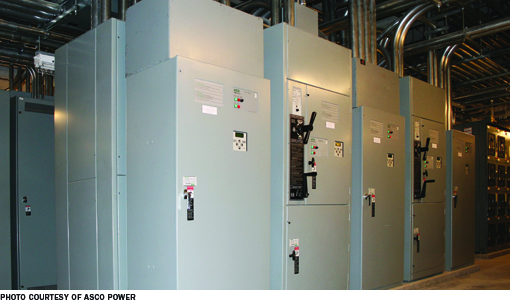 |
|---|
| Prentice Woman's Hospital used fiber-optic communications control circuitry to connect its generator sets and switchgear to 62 transfer switches. |
Two pairs of traditional hard wires carry the start signals from the transfer switches to the generator sets. This provides recognized reliability and helped get the variance required from the city for remotely locating the generator sets in another building.
For communication between the transfer switches and switchgear, two cables (one redundant) run from the switchgear to three remote terminal units. The terminals serve as interconnection points to the power transfer switches.
Fiber optics produced a number of benefits. For starters, it eliminated signal loss that otherwise would have occurred with hard wire due to the long distances. Ehret also recognized a monetary benefit. “Running two cables gave us a robust system and we didn’t have to buy all that copper twice,” he says, “and that saved a lot of dollars.”
There were initial concerns about fiber optic because emergency power was a fairly new application for it at the time. “But in the end, I think we produced a faster and more reliable system,” he says. “Information travels back and forth on that bus at a higher speed than it could on copper.”
It all added up to a powerful new medical facility that provides comprehensive women’s health care throughout all stages of life.
Shapes of reliability
Prentice Women's Hospital, Fred Hutch Cancer Research Center and Seattle Cancer Care Alliance, and the Bryan Medical Center East Campus show that power reliability for health care facilities can take many shapes.
Each solved the issue of enhancing the reliability of their CPMS with either more sophisticated power monitoring and control, the ability to service hot electrical gear or connecting far-flung gear reliably.
In all cases, the enhancements helped saved scarce dollars, increased power reliability and improved patient safety.
Bhavesh Patel is director of marketing for Columbus, Ohio-based Emerson Network Power’s ASCO Power business. He can be reached at Bhavesh.patel@emerson.com.



